The global mid wave mid-IR supercontinuum laser market is valued at USD 111.0 million in 2025 and is slated to reach USD 367.0 million by 2035, recording an absolute increase of USD 256.0 million over the forecast period. This translates into a total growth of 230.6%, with the market forecast to expand at a compound annual growth rate (CAGR) of 12.7% between 2025 and 2035.
The overall market size is expected to grow by nearly 3.31X during the same period, supported by increasing demand for advanced spectroscopic applications, growing adoption of high-resolution sensing technologies in defense and environmental monitoring sectors, and rising preference for broadband coherent light sources across scientific research and industrial measurement applications.
Between 2025 and 2030, the mid wave mid-IR supercontinuum laser market is projected to expand from USD 111.0 million to USD 179.1 million, resulting in a value increase of USD 68.1 million, which represents 26.6% of the total forecast growth for the decade.
This phase of development will be shaped by increasing adoption of advanced photonic technologies, rising demand for high-power broadband light sources, and growing emphasis on precision measurement systems with enhanced spectral coverage characteristics. Research institutions and industrial laboratories are expanding their optical instrumentation capabilities to address the growing demand for molecular detection applications, gas sensing requirements, and advanced imaging system implementations.
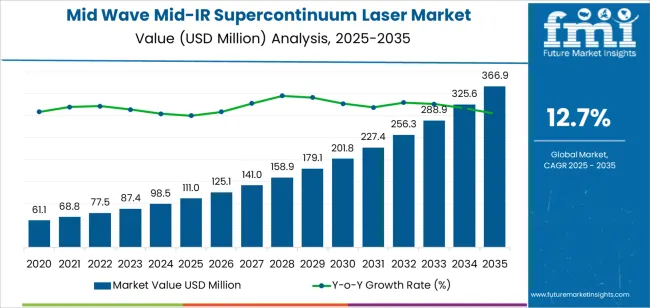
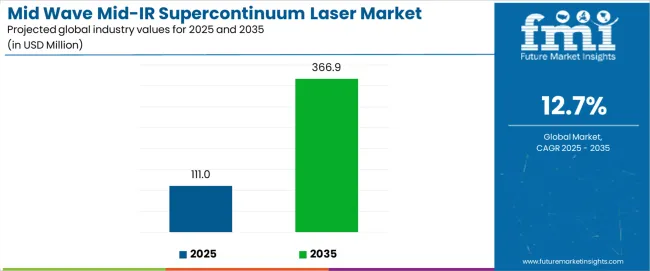
| Metric | Value |
|---|---|
| Estimated Value in (2025E) | USD 111.0 million |
| Forecast Value in (2035F) | USD 367.0 million |
| Forecast CAGR (2025 to 2035) | 12.7% |
From 2030 to 2035, the market is forecast to grow from USD 179.1 million to USD 367.0 million, adding another USD 187.9 million, which constitutes 73.4% of the overall ten-year expansion. This period is expected to be characterized by the expansion of quantum cascade laser technologies, the integration of fiber-based supercontinuum sources, and the development of compact laser platforms with enhanced stability and power output capabilities. The growing adoption of precision sensing applications will drive demand for mid wave mid-IR supercontinuum lasers with superior coherence properties and compatibility with advanced detection systems across scientific and industrial operations.
Between 2020 and 2025, the mid wave mid-IR supercontinuum laser market experienced robust growth, driven by increasing demand for advanced optical sensing technologies and growing recognition of supercontinuum sources as essential tools for high-resolution spectroscopic measurements across defense applications, environmental monitoring, and scientific research programs.
The market developed as researchers recognized the potential for these lasers to enable unprecedented spectral coverage while maintaining coherence properties and enabling precision measurement protocols. Technological advancement in fiber laser architectures and nonlinear optical processes began emphasizing the critical importance of maintaining power stability and beam quality in diverse measurement environments.
Market expansion is being supported by the increasing global demand for advanced photonic sensing solutions and the corresponding need for broadband coherent light sources that can provide superior spectral coverage and measurement precision while enabling reduced detection limits and enhanced system performance across various scientific and industrial measurement applications.
Modern research facilities and sensing system manufacturers are increasingly focused on implementing laser technologies that can deliver exceptional bandwidth characteristics, prevent measurement limitations, and provide consistent spectral output throughout complex detection scenarios and diverse analytical conditions. Mid wave mid-IR supercontinuum lasers' proven ability to deliver exceptional coherence across broad spectral ranges, enable time-efficient measurements, and support high-resolution analytical protocols make them essential tools for contemporary scientific research and industrial sensing operations.
The growing emphasis on precision measurement and advanced sensing capabilities is driving demand for mid wave mid-IR supercontinuum lasers that can support high-resolution spectroscopic requirements, improve detection sensitivity outcomes, and enable automated measurement systems.
Researchers' preference for technology that combines exceptional spectral coverage with operational stability and measurement accuracy is creating opportunities for innovative laser implementations. The rising influence of quantum photonics and precision sensing practices is also contributing to increased demand for mid wave mid-IR supercontinuum lasers that can provide coherent broadband illumination, real-time measurement capabilities, and reliable performance across extended operational periods.
The mid wave mid-IR supercontinuum laser market is poised for rapid growth and transformation. As industries across defense, environmental monitoring, scientific research, and industrial sensing seek solutions that deliver exceptional spectral coverage, measurement precision, and detection sensitivity, mid wave mid-IR supercontinuum lasers are gaining prominence not just as specialized equipment but as strategic enablers of advanced photonic sensing and precision measurement practices.
Rising quantum sensing adoption in defense applications and expanding precision measurement initiatives globally amplify demand, while manufacturers are leveraging innovations in fiber laser architectures, nonlinear optical processes, and integrated detection systems.
Pathways like high-power broadband platforms, coherent detection systems, and specialized sensing solutions promise strong margin uplift, especially in defense and scientific research segments. Geographic expansion and technology integration will capture volume, particularly where local research capabilities and precision sensing adoption are critical. Regulatory support around defense modernization, environmental monitoring requirements, and scientific research standards give structural support.
The market is segmented by type, application, power output, end-use sector, and region. By type, the market is divided into narrow band and wide band categories. By application, it covers spectral analysis, environmental monitoring, national defense security, and others. By power output, the market includes high power systems (>500mW), medium power systems (100-500mW), and low power systems (<100mW). By end-use sector, it is categorized into defense and security, scientific research, industrial measurement, and environmental monitoring. Regionally, the market is divided into North America, Europe, East Asia, South Asia & Pacific, Latin America, and the Middle East & Africa.
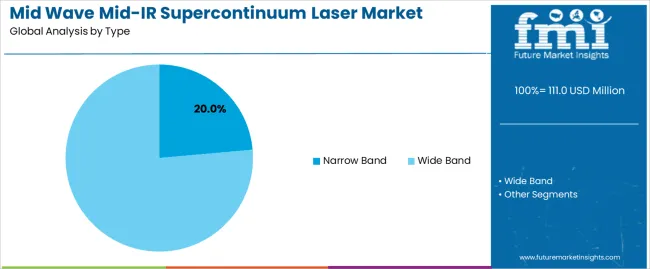
The wide band segment is projected to account for 64.8% of the mid wave mid-IR supercontinuum laser market in 2025, reaffirming its position as the leading type category. Scientific research institutions and industrial measurement facilities increasingly utilize wide band supercontinuum lasers for their superior spectral coverage capabilities when operating across diverse analytical applications, excellent coherence characteristics, and effectiveness in applications ranging from molecular detection to broadband sensing measurements.
Wide band supercontinuum laser technology's advanced spectral generation capabilities and extended wavelength coverage directly address the industrial requirements for comprehensive measurement capabilities in high-resolution analytical environments.
This type segment forms the foundation of modern photonic sensing operations, as it represents the laser type with the greatest measurement versatility and established market demand across multiple application categories and research sectors. Manufacturer investments in enhanced nonlinear fiber technologies and automated wavelength control systems continue to strengthen adoption among research institutions and industrial laboratories. With organizations prioritizing measurement flexibility and spectral coverage optimization, wide band supercontinuum lasers align with both performance requirements and analytical efficiency objectives, making them the central component of comprehensive photonic measurement strategies.
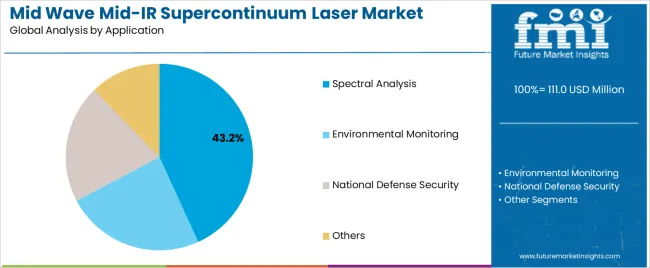
Spectral analysis applications are projected to represent 43.2% of mid wave mid-IR supercontinuum laser demand in 2025, underscoring their critical role as the primary consumers of broadband coherent light technology for molecular identification, chemical analysis, and advanced measurement applications.
Spectral analysis operators prefer supercontinuum lasers for their exceptional spectral coverage capabilities, high coherence operational characteristics, and ability to enable high-resolution measurements while ensuring consistent performance throughout diverse analytical programs. Positioned as essential equipment for modern analytical laboratories, supercontinuum lasers offer both measurement precision advantages and detection sensitivity benefits.
The segment is supported by continuous innovation in fiber laser technologies and the growing availability of specialized detection systems that enable variable wavelength operation with enhanced measurement accuracy and rapid analysis capabilities.
Additionally, analytical laboratories are investing in integrated measurement systems to support comprehensive spectroscopic utilization and research planning. As precision measurement demand becomes more prevalent and analytical sensitivity requirements increase, spectral analysis applications will continue to dominate the end-use market while supporting advanced photonic measurement utilization and detection optimization strategies.
The mid wave mid-IR supercontinuum laser market is advancing rapidly due to increasing demand for advanced photonic sensing technologies and growing adoption of broadband coherent light sources that provide superior spectral coverage and measurement precision while enabling enhanced detection capabilities across diverse scientific and industrial measurement applications. However, the market faces challenges, including high initial equipment costs, complex system integration requirements, and the need for specialized technical expertise and maintenance protocols. Innovation in fiber laser architectures and coherent detection capabilities continues to influence product development and market expansion patterns.
Expansion of Quantum and Coherent Detection Technologies
The growing adoption of quantum sensing systems, coherent detection algorithms, and advanced signal processing optimization is enabling manufacturers to produce sophisticated supercontinuum lasers with superior coherence capabilities, enhanced measurement precision, and automated detection protocol functionalities. Advanced coherent systems provide improved measurement sensitivity while allowing more efficient spectral utilization and consistent performance across various sensing applications and environmental conditions. Manufacturers are increasingly recognizing the competitive advantages of coherent laser capabilities for measurement differentiation and premium market positioning.
Integration of Compact and Portable System Designs
Modern supercontinuum laser producers are incorporating miniaturized architectures, battery operation capabilities, and ruggedized packaging systems to enhance field deployment potential, enable portable measurement capabilities, and deliver value-added solutions to defense and environmental customers. These technologies improve operational flexibility while enabling new measurement capabilities, including field spectroscopy, remote sensing applications, and reduced operational complexity. Advanced system integration also allows manufacturers to support comprehensive measurement platforms and sensing modernization beyond traditional laboratory-based measurement approaches.
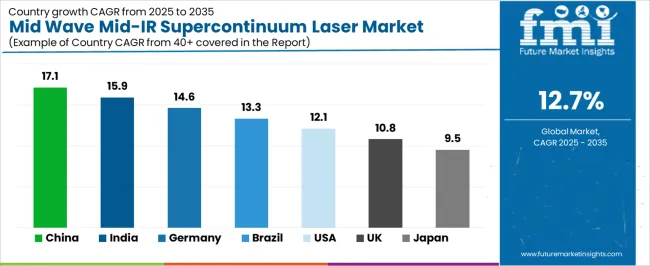
| Country | CAGR (2025 to 2035) |
|---|---|
| China | 17.1% |
| India | 15.9% |
| Germany | 14.6% |
| Brazil | 13.3% |
| USA | 12.1% |
| UK | 10.8% |
| Japan | 9.5% |
The mid wave mid-IR supercontinuum laser market is experiencing strong growth globally, with China leading at a 17.1% CAGR through 2035, driven by expanding defense modernization programs, growing precision sensing adoption, and significant investment in photonic technology development. India follows at 15.9%, supported by government initiatives promoting advanced sensing technology, increasing research infrastructure development, and growing national security requirements. Germany shows growth at 14.6%, emphasizing precision measurement innovation and advanced photonic technology development.
Brazil records 13.3%, focusing on environmental monitoring expansion and scientific research modernization. The USA demonstrates 12.1% growth, prioritizing defense technology standards and sensing system excellence. The UK exhibits 10.8% growth, emphasizing photonic technology adoption and precision measurement development. Japan shows 9.5% growth, supported by high-tech sensing initiatives and precision photonic concentration.
The report covers an in-depth analysis of 40+ countries top-performing countries are highlighted below.
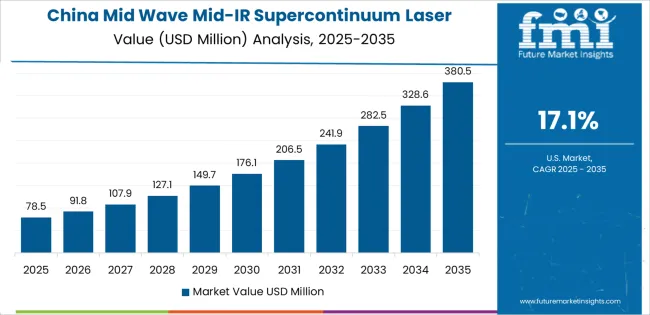
Revenue from mid wave mid-IR supercontinuum lasers in China is projected to exhibit exceptional growth with a CAGR of 17.1% through 2035, driven by expanding defense modernization programs and rapidly growing precision sensing adoption supported by government initiatives promoting photonic technology development. The country's strong position in laser manufacturing and increasing investment in advanced sensing infrastructure are creating substantial demand for sophisticated supercontinuum laser solutions. Major defense contractors and research institutions are establishing comprehensive laser system capabilities to serve both domestic sensing demand and advanced technology markets.
Revenue from mid wave mid-IR supercontinuum lasers in India is expanding at a CAGR of 15.9%, supported by the country's growing defense sector, expanding government support for research modernization, and increasing adoption of advanced sensing solutions. The country's initiatives promoting photonic technology and growing institutional awareness are driving requirements for sophisticated measurement capabilities. International suppliers and domestic manufacturers are establishing extensive production and service capabilities to address the growing demand for supercontinuum laser products.
Revenue from mid wave mid-IR supercontinuum lasers in Germany is expanding at a CAGR of 14.6%, supported by the country's advanced precision measurement capabilities, strong emphasis on photonic technology innovation, and robust demand for high-performance optical systems in research and industrial measurement applications. The nation's mature photonics sector and technology-focused operations are driving sophisticated supercontinuum laser systems throughout the research industry. Leading manufacturers and technology providers are investing extensively in fiber laser systems and coherent detection technologies to serve both domestic and international markets.
Revenue from mid wave mid-IR supercontinuum lasers in Brazil is growing at a CAGR of 13.3%, driven by the country's expanding environmental monitoring sector, growing research institutions, and increasing investment in sensing technology development. Brazil's environmental research focus and commitment to scientific advancement are supporting demand for efficient supercontinuum laser solutions across multiple sensing applications. Manufacturers are establishing comprehensive service capabilities to serve the growing domestic market and environmental monitoring opportunities.
Revenue from mid wave mid-IR supercontinuum lasers in the USA is expanding at a CAGR of 12.1%, supported by the country's advanced defense technology sector, strategic focus on sensing innovation, and established photonic research capabilities. The USA's technology leadership and system integration are driving demand for supercontinuum lasers in defense applications, scientific research, and industrial sensing applications. Manufacturers are investing in comprehensive technology development to serve both domestic defense markets and international scientific applications.
Revenue from mid wave mid-IR supercontinuum lasers in the UK is growing at a CAGR of 10.8%, driven by the country's focus on photonic technology advancement, emphasis on precision measurement, and strong position in optical system development. The UK's established photonics innovation capabilities and commitment to research modernization are supporting investment in advanced laser technologies throughout major research regions. Industry leaders are establishing comprehensive technology integration systems to serve domestic research operations and specialized sensing applications.
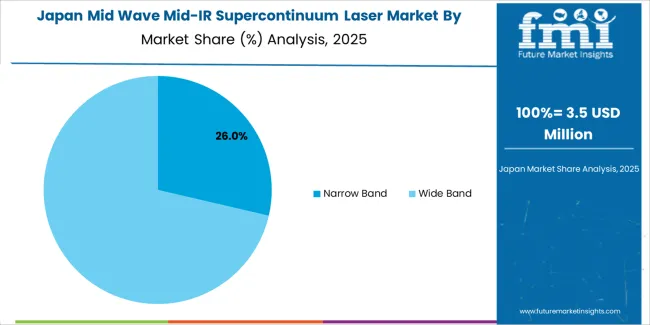
Revenue from mid wave mid-IR supercontinuum lasers in Japan is expanding at a CAGR of 9.5%, supported by the country's high-tech sensing initiatives, growing precision photonics sector, and strategic emphasis on optical system development. Japan's advanced technology capabilities and integrated sensing systems are driving demand for sophisticated supercontinuum lasers in precision measurement, advanced research, and high-performance sensing applications. Leading manufacturers are investing in specialized capabilities to serve the stringent requirements of high-tech sensing and precision measurement industries.
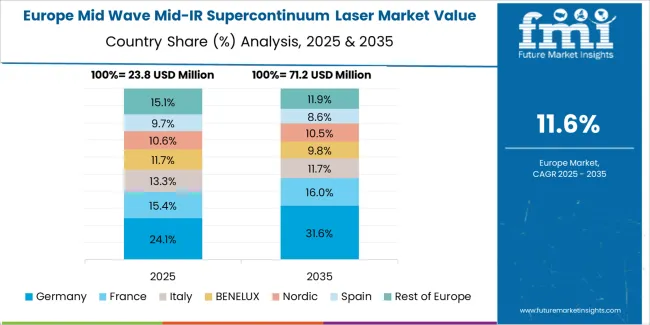
The mid wave mid-IR supercontinuum laser market in Europe is projected to grow from USD 22.2 million in 2025 to USD 58.4 million by 2035, registering a CAGR of 10.2% over the forecast period. Germany is expected to maintain its leadership position with a 38.5% market share in 2025, declining slightly to 37.9% by 2035, supported by its strong precision photonics sector, advanced optical technology capabilities, and comprehensive photonic research industry serving diverse supercontinuum laser applications across Europe.
France follows with a 19.3% share in 2025, projected to reach 19.8% by 2035, driven by robust demand for supercontinuum lasers in defense applications, scientific research programs, and precision measurement applications, combined with established photonic technology infrastructure and advanced research expertise.
The United Kingdom holds a 17.2% share in 2025, expected to reach 17.6% by 2035, supported by strong photonic technology sector and growing precision sensing activities. Italy commands a 11.4% share in 2025, projected to reach 11.7% by 2035, while Spain accounts for 8.6% in 2025, expected to reach 8.9% by 2035.
The Netherlands maintains a 3.8% share in 2025, growing to 4.1% by 2035. The Rest of Europe region, including Nordic countries, Eastern Europe, Belgium, Poland, and other nations, is anticipated to maintain momentum, with its collective share moving from 1.2% to 0% by 2035, attributed to increasing research modernization in Eastern Europe and growing precision sensing penetration in Nordic countries implementing advanced photonic technology programs.
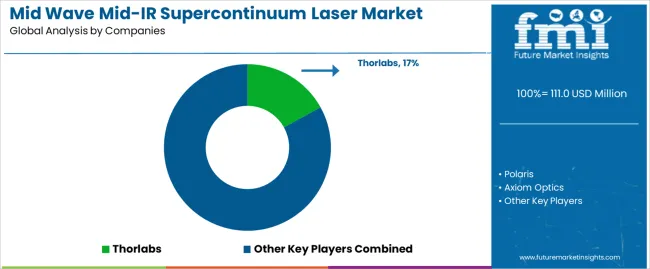
The mid wave mid-IR supercontinuum laser market is characterized by competition among established photonic companies, specialized laser manufacturers, and integrated sensing solutions providers. Companies are investing in fiber laser technology research, coherence optimization, spectral coverage enhancement, and comprehensive product portfolios to deliver consistent, high-performance, and application-specific supercontinuum laser solutions. Innovation in nonlinear optical processes, coherent detection integration, and measurement precision enhancement is central to strengthening market position and competitive advantage.
Thorlabs leads the market with a strong market share, offering comprehensive supercontinuum laser solutions including advanced fiber architectures with a focus on scientific and research applications. Polaris provides specialized photonic capabilities with an emphasis on coherent light generation and automated sensing operations. Axiom Optics delivers innovative sensing products with a focus on high-power platforms and defense applications. SIMTRUM specializes in precision photonics and supercontinuum laser technologies for advanced measurement applications.
| Items | Values |
|---|---|
| Quantitative Units (2025) | USD 111 million |
| Type | Narrow Band, Wide Band |
| Application | Spectral Analysis, Environmental Monitoring, National Defense Security, Others |
| Power Output | High Power Systems (>500mW), Medium Power Systems (100-500mW), Low Power Systems (<100mW) |
| End-Use Sector | Defense and Security, Scientific Research, Industrial Measurement, Environmental Monitoring |
| Regions Covered | North America, Europe, East Asia, South Asia & Pacific, Latin America, Middle East & Africa |
| Countries Covered | China, India, Germany, Brazil, United States, United Kingdom, Japan and 40+ countries |
| Key Companies Profiled | Thorlabs, Polaris, Axiom Optics, and SIMTRUM |
| Additional Attributes | Dollar sales by type and application category, regional demand trends, competitive landscape, technological advancements in fiber laser systems, coherent detection development, nonlinear optics innovation, and sensing system integration |
The global mid wave mid-ir supercontinuum laser market is estimated to be valued at USD 111.0 million in 2025.
The market size for the mid wave mid-ir supercontinuum laser market is projected to reach USD 366.9 million by 2035.
The mid wave mid-ir supercontinuum laser market is expected to grow at a 12.7% CAGR between 2025 and 2035.
The key product types in mid wave mid-ir supercontinuum laser market are narrow band and wide band.
In terms of application, spectral analysis segment to command 43.2% share in the mid wave mid-ir supercontinuum laser market in 2025.






Full Research Suite comprises of:
Market outlook & trends analysis
Interviews & case studies
Strategic recommendations
Vendor profiles & capabilities analysis
5-year forecasts
8 regions and 60+ country-level data splits
Market segment data splits
12 months of continuous data updates
DELIVERED AS:
PDF EXCEL ONLINE
Middle East & Africa Sachet Packaging Machines Market Size and Share Forecast Outlook 2025 to 2035
Mid-Lift Axle Market Size and Share Forecast Outlook 2025 to 2035
Middle East & Africa Hydrolyzed Bovine Collagen Market Size and Share Forecast Outlook 2025 to 2035
Middle East Flooring and Carpet Industry Analysis Size and Share Forecast Outlook 2025 to 2035
Middle East and North Africa Frozen Food Market Size and Share Forecast Outlook 2025 to 2035
Middle East and Africa Bio-Stimulants Market Size and Share Forecast Outlook 2025 to 2035
Middle East and Africa Latex Foil Balloons Market Size and Share Forecast Outlook 2025 to 2035
Middle Mile Delivery Market Size and Share Forecast Outlook 2025 to 2035
Middle East & Africa Data Storage Market Report – Trends & Industry Forecast 2025–2035
Midstream Oil & Gas Analytics Market Size and Share Forecast Outlook 2025 to 2035
Middle East Veterinary Vaccine Market Analysis - Size, Share, and Forecast 2025 to 2035
Middle East and Africa Rough Terrain Cranes Market Growth - Trends & Forecast 2025 to 2035
Middle East/North Africa (MENA) Commercial Vehicles Market Analysis - Size, Share, and Forecast 2025 to 2035
Middle East Conveyor Belts Market - Growth & Demand 2025 to 2035
Analysis and Growth Projections for Middle East and Mediterranean Tahini Business
Middle East and Africa (MEA) Tourism Security Market Analysis 2025 to 2035
Middle East Paints & Coatings Market Growth – Trends & Forecast 2025 to 2035
Middle East Wood Flooring Market Growth – Trends & Forecast 2024-2034
MEA Stick Packaging Machines Market Growth – Trends & Forecast 2023-2033
Middle East 3D Printing Materials Market Trends 2022 to 2032

Thank you!
You will receive an email from our Business Development Manager. Please be sure to check your SPAM/JUNK folder too.
Chat With
MaRIA